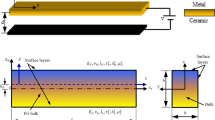Abstract
In this paper, the two-point boundary value problem (BVP) of the nano-cantilever deflection subjected to Casimir and electrostatic forces is investigated using analytical and numerical methods to obtain the instability point of the nano-beam. In the analytical treatment of the BVP, the nonlinear differential equation of the model is transformed into the integral form by using the Green’s function of the cantilever beam. Then, closed-form solutions are obtained by assuming an appropriate shape function for the beam deflection to evaluate the integrals. The pull-in parameters of the beam are computed under the combined effects of electrostatic and Casimir forces. Electrostatic microactuators and freestanding nanoactuators are considered as special cases of our study. The detachment length and the minimum initial gap of freestanding nanocantilevers, which are the basic design parameters for NEMS switches, are determined. The results of the analytical study are verified by numerical solution of the BVP. The centerline of the beam under the effect of electrostatic and Casimir forces at small deflections and at the point of instability is obtained numerically to test the validity of the shape function assumed for the beam deflection in the analytical investigation. Finally, the large deformation theory is applied in numerical simulations to study the effect of the finite kinematics on the pull-in parameters of nano-canilevers.























Similar content being viewed by others
References
Bernstein D, Guidotti P, Pelesko JA (2000) Mathematical analysis of an electrostatically actuated MEMS device. In: Proceedings of Modeling and Simulation of Microsystems (MSM), pp 489–492
Bochobza-Degani O, Nemirovsky Y (2002) Modeling the pull-in parameters of electrostatic actuators with a novel lumped two degrees of freedom pull-in model. Sens Actuators A 97–98:569–578
Cheng J, Zhe J, Wu X (2004) Analytical and finite element model pull-in study of rigid and deformable electrostatic microactuators. J Micromech Microeng 14:57–68
Ding JN, Wen SZ, Meng YG (2001) Theoretical study of the sticking of a membrane strip in MEMS under the Casimir effect. J Micromech Microeng 11:202–208
Gupta RK (1997) Electrostatic pull-in test structure design for in-situ mechanical property measurements of microelectromechanical systems. Ph.D. Thesis, MIT, Cambridge, MA
Haung JM, Liew KM, Wong CH, Rajendran S, Tan MJ, Liu AQ (2001) Mechanical design and optimization of capacitive micromachined switch. Sens Actuators A 1993:273–285
Israelachvili JN (1992) Intermolecular and surface forces. Academic, London
Johnstone RW, Parameswaran M (2002) Theoretical limits on the freestanding length of cantilevers produced by surface micromachining technology. J Micromech Microeng 12:855–861
Ke CH, Espinosa HD, Pugno N (2005a) Numerical analysis of nanotube based NEMS devices—part II: Role of finite kinematics, stretching and charge concentrations. J Appl Mech 72:726–731
Ke CH, Pugno N, Peng B, Espinosa HD (2005b) Experiments and modeling of carbon nanotube-based NEMS devices. J Mech Phys Solids 53:1314–1333
Kim P, Lieber CM (1999) Nanotube nanotweezers. Science 286:2148–2150
Lamoreaux SK (2005) The Casimir force: background, experiments, and applications. Rep Prog Phys 68:201–236
Lin WH, Zhao YP (2003) Dynamic behavior of nanoscale electrostatic actuators. Chin Phys Lett 20:2070–2073
Lin WH, Zhao YP (2005a) Casimir effect on the pull-in parameters of nanometer switches. Microsyst Thechnol 11:80–85
Lin WH, Zhao YP (2005b) Nonlinear behavior for nanoscale electrostatic actuators with Casimir force. Chaos Solitons Fractals 23:1777–1785
Mostepanenko VM, Trunov NN (1997) The Casimir effect and its application. Oxford Science, New York
The MathWorks Inc. Matlab 7 Help
Osterberg PM, Senturia SD (1997) M-TEST: a test chip for MEMS material property measurement using electrostatically actuated test structures. J Microelectromech Syst 6(2):107–118
Pelesko JA (2001) Multiple solutions in electrostatic MEMS. In: Proceedings of modeling and simulation of microsystems (MSM), pp 290–293
Pelesko JA, Bernstein DH (2003) Modeling MEMS and NEMS. Chapman & Hall/CRC, London
Petersen KE (1978) Dynamic micromechanics on silicon: techniques and devices. IEEE Trans Electron Devices ED-25(10):1241–1250
Ramezani A, Alasty A, Akbari J (2006) Influence of van der Waals force on the pull-in parameters of cantilever type nanoscale electrostatic actuators. J Microsyst Technol 12(12):1153–1161
Serry M, Walliser D, Maclay J (1995) The anharmonic Casimir oscillator. J Microelectromech Syst 4:193–205
Shampine LF, Reichelt MW, Kierzenka J. Solving boundary value problems for ordinary differential equations in MATLAB with bvp4c. Available at ftp://ftp.mathworks.com/pub/doc/papers/bvp/
Timoshenko S (1987) Theory of plates and shells. McGraw Hill, New York
Acknowledgments
The authors acknowledge the valuable comments of the reviewers. The first author (A. Ramezani) wishes to acknowledge the assistance of Dr. Panahi in preparation of this paper.
Author information
Authors and Affiliations
Corresponding author
Appendix
Appendix
Solutions of the integrals appearing in Eq. 24 are
Rights and permissions
About this article
Cite this article
Ramezani, A., Alasty, A. & Akbari, J. Analytical investigation and numerical verification of Casimir effect on electrostatic nano-cantilevers. Microsyst Technol 14, 145–157 (2008). https://doi.org/10.1007/s00542-007-0409-y
Received:
Accepted:
Published:
Issue Date:
DOI: https://doi.org/10.1007/s00542-007-0409-y




